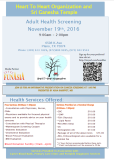
Heart Disease
Why is Heart Disease a Problem?
Around 610,000 people die of heart disease every year; that's one in four deaths. 735,000 people have a heart attack every year. Heart disease is the leading cause of death in America, and although causes and treatments are very complex; there are many steps that can be taken to reduce chances of and prevent heart disease. Although many forms of heart disease are congenital, many others are the result of unhealthy lifestyles. By promoting regular exercise and healthy eating we can work to reduce the rate of heart disease and prevent the life threatening symptoms of these diseases.
What causes Heart Disease?
The main causes of heart disease are high blood pressure, high low-density lipoprotein (LDL) choleserol levels, and smoking.
-
High blood pressure or hypertension (blood presssure over 140 systolic/90 diastolic) is often the result of drug use, smoking and second-hand smoke inhalation, alcohol abuse, and lack of balance in diet (too much salt, too much vitamin D, too little potassium). Certain lifestyle choices also can increase risk for high blood pressure, such as lack of physical activity, which leads to being overweight and requiring the heart to work harder to pump blood throughout the body. Furthermore, stress can result in an increase in blood pressure, and by engaging in stress relieving activities such as exercise and hobbies can promote a higher quality of life.
-
High LDL cholesterol levels or the bad cholesterol tend to collect on the walls of blood vessels, resulting in a buildup of plaque and atherosclerosis (the hardening and narrowing of blood vessels). This can result in higher blood pressure as the heart has to work harder to pump blood. If this buildup ruptures, a clot may form, resulting in heart attacks (flow of oxygen-rich blood is blocked to heart muscle resulting in muscle death).
-
Smoking cigarettes increases risk of heart disease by two to four times that of a non-smoker. Smoking reduces the amount of oxygen that the heart gets, increases blood pressure (in turn increasing heart rate and resulting in increased risk of blood clot formation), and harms blood vessels.
What can you do?
Although some forms of heart disease are congenital, many others are the result of various factors. Even if you have a strong family history of heart disease, there are many things to reduce your chances of developing heart disorders. Lifestyle changes are the first step towards heart healthy living. By eating a balanced diet based on the guidelines set forth by the US Department of Agriculture (http://www.choosemyplate.gov/) and by consuming foods low in sodium, total fat, saturated fat, and cholesterol and high in fresh fruits and vegetables, you can reduce risk factors of heart disease. Furthermore, regular exercise, whether through sports, hitting the gym, or something as simple as taking a 10 minute walk 3 times a day and five times a week, can reduce stress on heart and decrease risk for heart disease.




